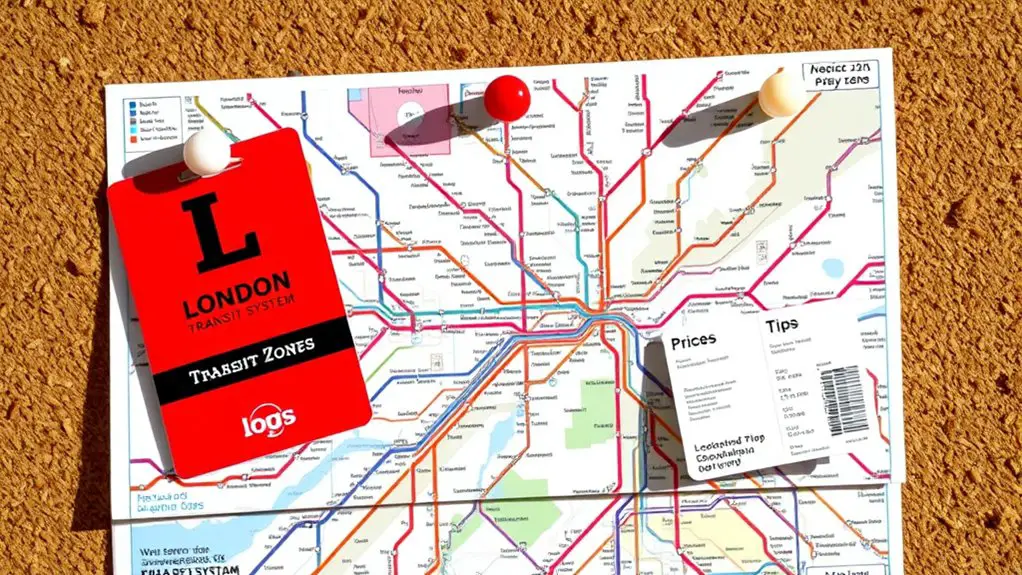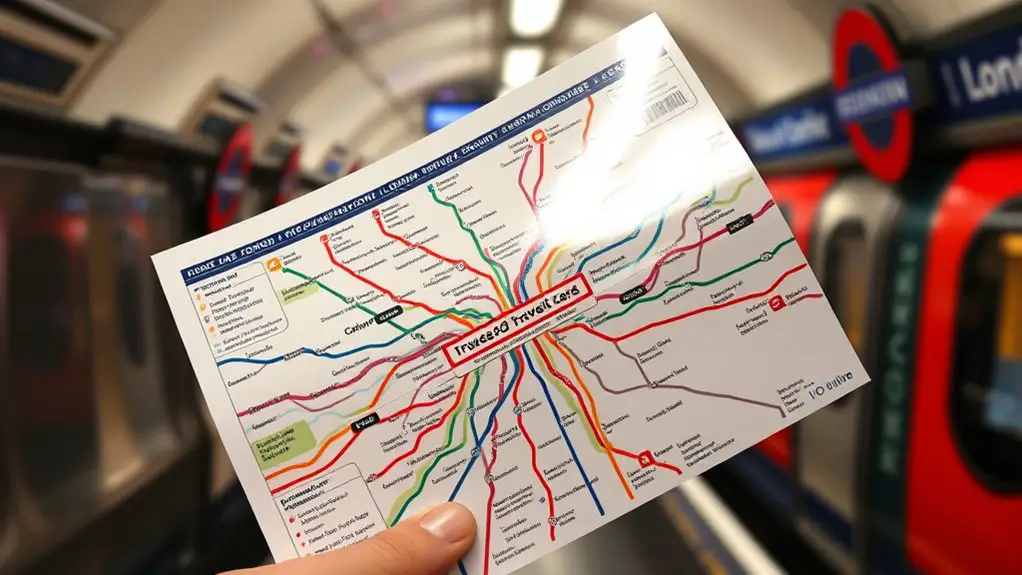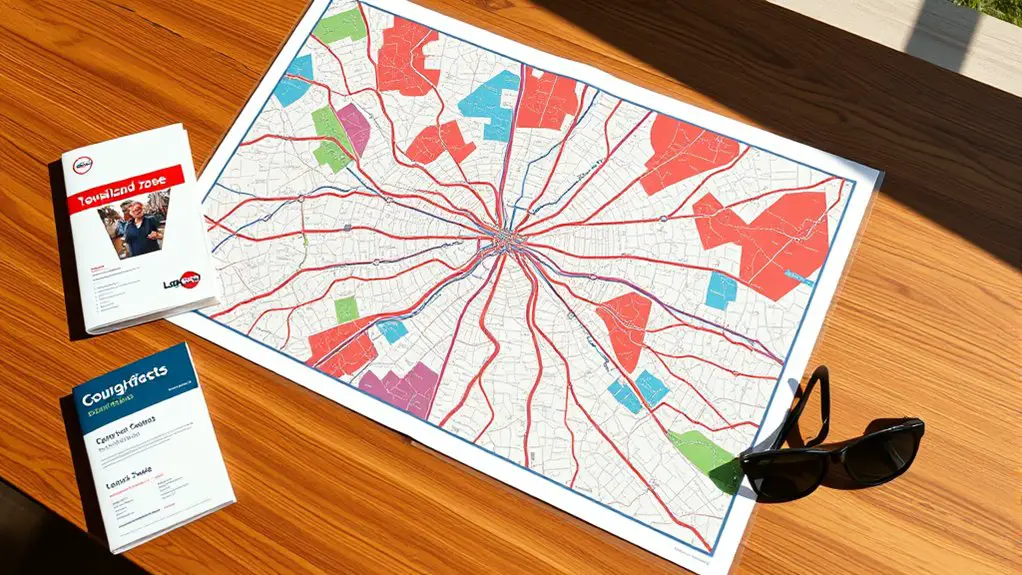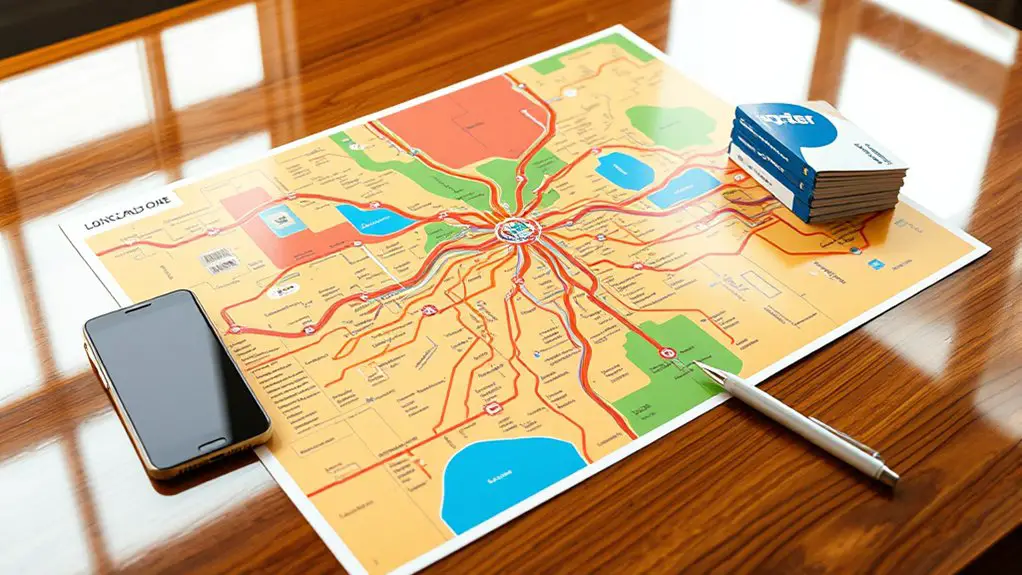Maneuvering London’s complex transit zones can seem intimidating, but understanding the pricing structure and zone boundaries is essential for an efficient journey. With a clear grasp of the official zone map and ticket options, you can make informed decisions that save money and reduce travel stress. As you explore the nuances of zone boundaries and transfer policies, you’ll discover strategies to optimize your travel plans—but there’s more to uncover that could greatly impact your experience.
Key Takeaways
- London Travelcards cover specific zones, with prices varying by zone and duration, offering unlimited travel within chosen areas.
- The official zone map uses concentric circles and color coding to clearly define boundaries and zones.
- Travelcards are available in paper, Oyster card, or contactless formats for daily, weekly, or monthly use.
- Using an Oyster or Travelcard often provides discounts, fare caps, and cost savings compared to single tickets.
- Planning routes ahead and understanding zone boundaries helps optimize cost and avoid unexpected charges.
Understanding the London Transit Zone System

To navigate London’s complex transportation network effectively, understanding the transit zone system is essential. Zone definitions categorize the city into concentric areas that influence fare pricing and ticket options.
These zones are numbered from 1 to 6, with Zone 1 covering central London and higher numbers extending outward. Zone boundaries are clearly demarcated, but they can sometimes be subtle, especially where transport routes cross into different zones.
Zones are numbered 1 to 6, with boundaries sometimes subtle where routes cross into different zones.
Recognizing these boundaries helps you determine fare zones accurately, ensuring you purchase the most cost-effective Travelcard or ticket. Keep in mind that zone boundaries are based on geographic and transport network considerations, not administrative borders.
This structure simplifies fare calculation and ticket validation, but it also requires awareness of zone overlaps and changes. By understanding how zone definitions relate to physical boundaries, you can plan your journeys more efficiently and avoid unexpected charges.
How to Read the Official Zone Map

The official London Zone Map is an essential tool for traversing the city’s transit system effectively. It clearly delineates zone boundaries, helping you determine the most cost-effective travel options based on your destinations.
The map uses concentric circles and color coding to distinguish zones, making it easier to plan routes and understand fare zones. Pay close attention to boundary lines, as crossing from one zone to another often affects ticket prices. Understanding how zone boundaries are represented helps you avoid unexpected charges and simplifies your journey planning.
Additionally, the map highlights areas prone to travel disruptions, such as construction zones or areas with frequent delays. Recognizing these zones allows you to anticipate delays and choose alternative routes proactively.
Types of Travelcards and Ticket Options

Understanding the variety of Travelcards and ticket options available in London is essential for optimizing your travel expenses and ensuring seamless journeys.
Travelcard benefits include unlimited travel within chosen zones, offering convenience and cost efficiency for frequent travelers. You can select from different types, such as paper Travelcards, Oyster card daily caps, or contactless payments, each providing varying levels of ticket flexibility.
For instance, Travelcards can be purchased for specific durations—daily, weekly, or monthly—allowing you to tailor your travel plan to your schedule. Ticket flexibility is vital, as it lets you switch modes or zones without additional costs if your plans change.
Some options also combine travel modes, like buses and trains, offering broader access. By understanding these options, you can choose the most suitable Travelcard type, maximize your benefits, and avoid unnecessary expenses, all while enjoying seamless mobility across London’s extensive transport network.
Prices for Different Zones and Travelcard Durations
Understanding the pricing structure across zones and durations helps you choose the most cost-effective Travelcard.
Your costs vary depending on the zones you travel through and the length of your ticket, making comparison essential.
Zone-based Pricing Structure
Travelcard prices in London vary considerably depending on the zones you travel through and the duration of your ticket.
Zone advantages influence pricing impact, as traveling within central zones typically costs less than crossing multiple zones. For example, a Travelcard covering Zone 1 offers more affordable options for city center travel, while extending into outer zones increases costs due to the greater distance.
The structure encourages efficiency, with higher prices for broader zone coverage reflecting the increased travel demand. Ticket durations—such as daily, weekly, or monthly passes—also affect pricing, with longer durations offering better value per day.
This zone-based pricing structure balances affordability for short-term travelers and revenue needs for transport providers, aligning costs with travel demand and zone complexity.
Duration and Ticket Types
The cost of a London Travelcard varies considerably based on both the zones you choose and the duration of your ticket.
Travelcard validity depends on whether you select daily, weekly, monthly, or longer options, each suited to different travel needs. Short-term tickets, like daily or weekly passes, are ideal for visitors or occasional travelers, while longer-term options offer cost savings for frequent users.
You can also consider ticket upgrades, such as adding Oyster pay-as-you-go credit or combining with other fare products, to enhance flexibility and potentially reduce costs.
Understanding the different ticket types helps you optimize your travel budget. Remember, selecting the right duration and ticket upgrade guarantees your Travelcard offers maximum convenience and value for your specific travel plans across London’s zones.
Cost Comparison by Zones
Prices for London Travelcards vary greatly depending on the zones you travel through and the duration of your ticket. Your zone fare directly impacts your overall travel savings, with certain zones offering more cost-effective options.
- Traveling within Zone 1-2 generally provides the lowest fare for short-term trips, maximizing your travel savings.
- Expanding to Zones 1-4 or 1-5 increases costs but offers greater flexibility for longer journeys.
- Monthly and annual Travelcards offer significant discounts, especially if covering multiple zones regularly.
- Single-ride fares are higher per trip but may be beneficial for occasional travel, whereas travel passes reduce costs over time.
Understanding how zone fare varies helps you choose the most economical ticket type based on your travel pattern.
Tips for Saving Money on Transit Fares
To save money on transit fares, make certain to use an Oyster card or a Travelcard, which offer discounted rates compared to single tickets.
Planning your journeys in advance helps you avoid unnecessary expenses and guarantees you select the most cost-effective options.
Implementing these strategies can greatly reduce your overall transportation costs across London’s zones.
Use Travelcard and Oyster
Using a Travelcard or Oyster card is one of the most effective ways to reduce transit costs in London.
Oyster benefits include discounted fares, daily caps, and easier access across multiple modes of transport. Travelcard advantages offer unlimited travel within selected zones, ideal for frequent commuters.
To maximize savings:
- Opt for Oyster if you’re making fewer trips—it’s flexible and offers pay-as-you-go benefits.
- Choose a Travelcard for extensive travel across multiple zones—best for daily commuters.
- Use contactless payments with Oyster or bank cards to enjoy daily fare caps without needing a physical card.
- Regularly check fare zones and caps to guarantee you’re not overpaying for your travel patterns.
Plan Journeys in Advance
Planning your journeys ahead of time can greatly cut transportation costs in London. Effective journey planning enables you to identify the most economical routes and avoid unnecessary travel.
By analyzing your destinations, you can optimize your route to minimize fare zones or transfer points, saving money on Travelcards or pay-as-you-go fares. Use tools like online journey planners and route optimization apps to compare different options, ensuring you choose the fastest and cheapest routes.
This proactive approach reduces unnecessary trips and helps you avoid peak-time surcharges. Additionally, planning in advance allows you to take advantage of discounts on off-peak travel and special fare options.
Ultimately, strategic journey planning and route optimization lead to smarter, more cost-effective travel across London’s transit network.
Navigating Zone Boundaries and Transfers
Understanding zone boundaries is essential for efficient travel across London’s transport network, as they determine fare calculations and valid routes.
Recognizing where zone boundaries lie helps you plan transfers effectively and avoid unnecessary costs.
- Familiarize yourself with the map, noting boundary lines that separate zones to anticipate fare changes.
- Use Oyster or contactless cards to benefit from fare capping when crossing multiple zones, optimizing costs.
- Consider transfer options at key interchange stations—such as King’s Cross St Pancras or Stratford—to switch lines or zones seamlessly.
- Be aware that some stations straddle zones, allowing flexible travel within boundary lines, which can save you money and time.
Additional Resources and Travel Planning Tips
Exploring additional resources can greatly enhance your travel experience in London. Using reliable travel apps can provide real-time updates on service disruptions, route options, and fare calculations, making trip planning more efficient.
Offline maps are particularly valuable for traversing unfamiliar areas without relying on data, guaranteeing you stay on course even when connectivity issues arise. Combining these tools enables you to optimize your travel, avoid delays, and maximize time spent exploring.
Additionally, many apps offer features like route planning for different modes of transport—buses, trains, and walking—allowing you to tailor your journey to your preferences and budget. Supplementing digital resources with printed maps or guides can also serve as a backup, especially during busy periods when app performance might be hindered.
Frequently Asked Questions
Are There Discounts for Seniors or Students on Travelcards?
Yes, seniors and students can access discounts on travelcards.
Senior discounts are available for those aged 60 and over, often through schemes like the Oyster card or Railcards, which provide reduced fares.
Students benefit from special student fares or discounts with valid identification, making travel more affordable.
These discounts help lower transportation costs for eligible travelers, making it easier to explore London while saving money on regular fares.
Can I Use Contactless Payments Instead of Travelcards?
Yes, you can use contactless payments instead of travelcards.
Contactless payment benefits include convenience, quicker tap-in and tap-out, and no need to carry a separate card.
When comparing travelcard vs. contactless, the latter offers flexibility for occasional travelers and seamless integration with other contactless payment methods.
Just verify your contactless card or device is accepted on the transport network, and you’ll enjoy the same fare benefits without purchasing a travelcard.
How Often Do Zone Boundaries Change?
Zone boundaries in London typically change infrequently, with adjustments driven by transportation needs and city development.
You should stay updated on boundary definitions, as occasional zone adjustments can affect fare calculations and travel planning. Authorities review boundary definitions periodically, but major changes are rare and usually announced well in advance.
Regularly checking official Transport for London updates guarantees you’re aware of any adjustments that might impact your travel routes and costs.
Is There a Daily Cap for Contactless or Travelcard Spending?
Yes, there’s a daily cap for contactless spending and Travelcards.
Once you reach this limit, your fares are automatically capped, meaning you won’t pay more on that day.
The daily caps vary depending on the zones you travel through, ensuring cost-effective travel for frequent users.
This system helps you plan your expenses, preventing unexpected charges and making daily travel more affordable and predictable.
Can I Buy a Travelcard Online Before Arriving in London?
Yes, you can buy a travelcard online before arriving in London through official transport websites or authorized vendors, ensuring convenience and time savings.
Online purchase options often include e-tickets or travelcards linked to contactless payment methods, which remain valid as long as they’re used within the travelcard’s validity period.
This approach helps you plan better and avoid queues, providing seamless access to London’s transport network from the moment you arrive.
Conclusion
Understanding the London Travelcard zones helps you optimize your travel costs and avoid surprises. By mastering the zone map, choosing the right ticket type, and planning your journeys wisely, you can save money and reduce stress. Using an Oyster card and staying aware of zone boundaries guarantees a smooth experience. Ultimately, informed planning enables you to navigate London’s transit system efficiently, making your visit both affordable and enjoyable.
